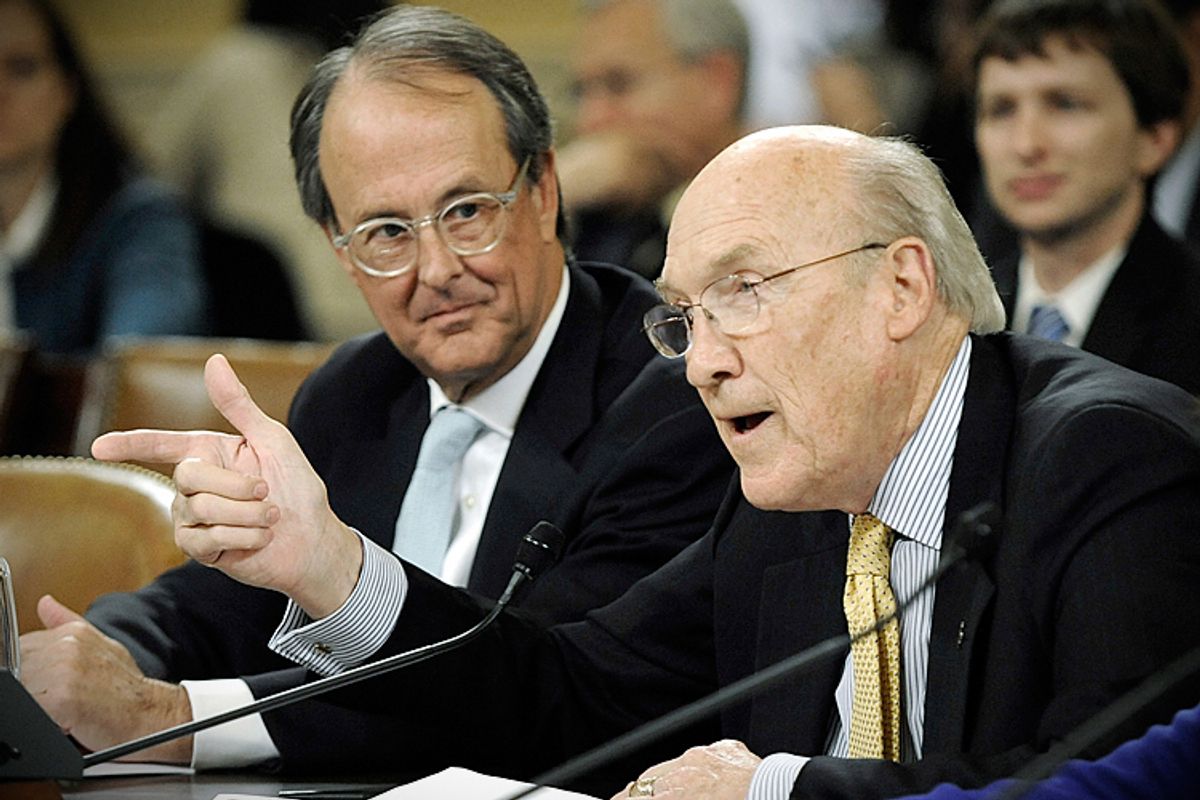That deficit demolishing duo of distinction —Simpson/Bowles—is at it again, out with the shell of a new planto reduce the deficit by $2.4 trillion over the next decade.
My first reaction was “really??…another new plan??…we need that!??” My second was “why $2.4 trillion?” We at CBPP have argued that our first order goal should be to stabilize the debt over the decade, and to do so would take about another $1.5 trillion in deficit reduction ($1.3 trillion in policy savings and the rest in interest savings). My third reaction was, “Why did the White House elevate these guys and was that a mistake?”
Re reaction #1 (do we need another plan?) these two dudes are deeply ensconced in this debate—and quite passionate about it—and there’s no stopping them from weighing in. Among the minority that’s actually looked closely at what they’ve proposed, you won’t find anyone who agrees with all of their ideas, as they’d be the first to admit. But they certainly have very high standing on the issue of the national debt.
That said, this new plan doesn’t look to be very helpful (reaction #2). The White House is on board with the $1.5 trillion for debt stabilization, which would replace the sequester with as-yet-unspecified balance between new revenues and more spending cuts (the administration’s budget plan will be out in a matter of weeks in their budget—another reason for S/B to hold their fire for now).
This will already be an extremely heavy lift and one that if not done thoughtfully, will inflict more fiscal wounds on an economy still struggling to heal (something S/B warn about, to their credit). S/B’s main rationale for another $900 billion in deficit savings seems to be that they want the debt to GDP ratio to hit 70% in ten years as opposed to the 73% that we target in our report.
As I’ve argued in lots of places, there are good reasons to stabilize at lower levels and even better reasons not to get so wound up about the level of the debt ratio, as much as the change. A credible budget plan should first stop the debt from growing faster than the economy and do so in a way that doesn’t hurt the current recovery or compromise critical investment, retirement security, and investment functions of the government. There’s diverse thinking about how to do this, with EPI on one side, us in the middle, and S/B pushing for more.
Well, we need to see their details, which they say will be out in “coming weeks,” but their framework implies cuts to NDD (non-defense discretionary) and to health programs that go well beyond what I believe is necessary at great risk to these critical functions. For example, I expect their details will show $400-500 billion more in discretionary cuts (likely divided between defense and non-defense, but don’t count on Congress to maintain that split). As Richard Kogan points out here, however, under the current NDD caps, these programs will already be squeezed.
And their $600 billion in health care cuts goes beyond the President’s proposed $400 billion and implies, bolstered by some of S/B’s language today, increases in the Medicare eligibility age, a singularly bad idea that would not only shift costs, as oppose to generate savings, but would add costs to the system in toto.
Finally, as Ezra Klein points out, their new plan looks like it tilts a lot more toward spending cuts and away from new revenues, and is thus not nearly as balanced as their original plan.
So, reaction #3: did the WH create a monster by commissioning them to come up with a fiscal plan in the first place? It’s a good question that has been surprisingly unexplored. Certainly, the WH took a ton of flack for creating the commission and then allegedly ignoring their recommendations. Except they didn’t. They embraced a number of S/B’s central ideas, including balancing new revenue and spending cuts, protecting low-income programs, and targeting about $4 trillion in terms of stabilization.
Of course, the administration could have done that without a commission and since then, S/B have become a moving target, one that seems increasingly divorced from careful, balanced fiscal policy that doesn’t endanger the economy or needlessly slash away at social insurance and key discretionary investments including those that protect and invest in the poor. So while I don’t know what the final verdict will be, appointing the commission may ultimately be seen as an “own-goal,” as they say (that’s where you kick the soccer ball in your own goal).
Note: Commenter Bearpaw reminds me that the S/B commission never made official recommendations. They failed to get the needed votes for an official endorsement.



Shares